SBM4201: System Design and Analysis Portfolio Assessment Report
VerifiedAdded on 2023/06/09
|9
|1082
|194
Report
AI Summary
This report provides a comprehensive analysis of system design principles, focusing on entities, attributes, use cases, and actors within the context of two case studies: Middle East College and Sydney Dentist Centre. The report begins by defining key concepts such as attributes, entities, and their relationships, emphasizing the role of primary keys. It then explores the use of actors and use cases in system analysis, including the 'include' and 'extend' relationships in use case diagrams. The report delves into the specifics of the registration systems at both Middle East College and Sydney Dentist Centre, identifying entities, attributes, actors, and use cases within each system. Use case diagrams are presented to visualize the processes. The assumptions made for each case study are also described. The report references relevant literature to support its findings and analysis. This report is designed to meet the requirements of the SBM4201 System Analysis and Design Portfolio Assessment, demonstrating an understanding of system development and data modeling concepts.
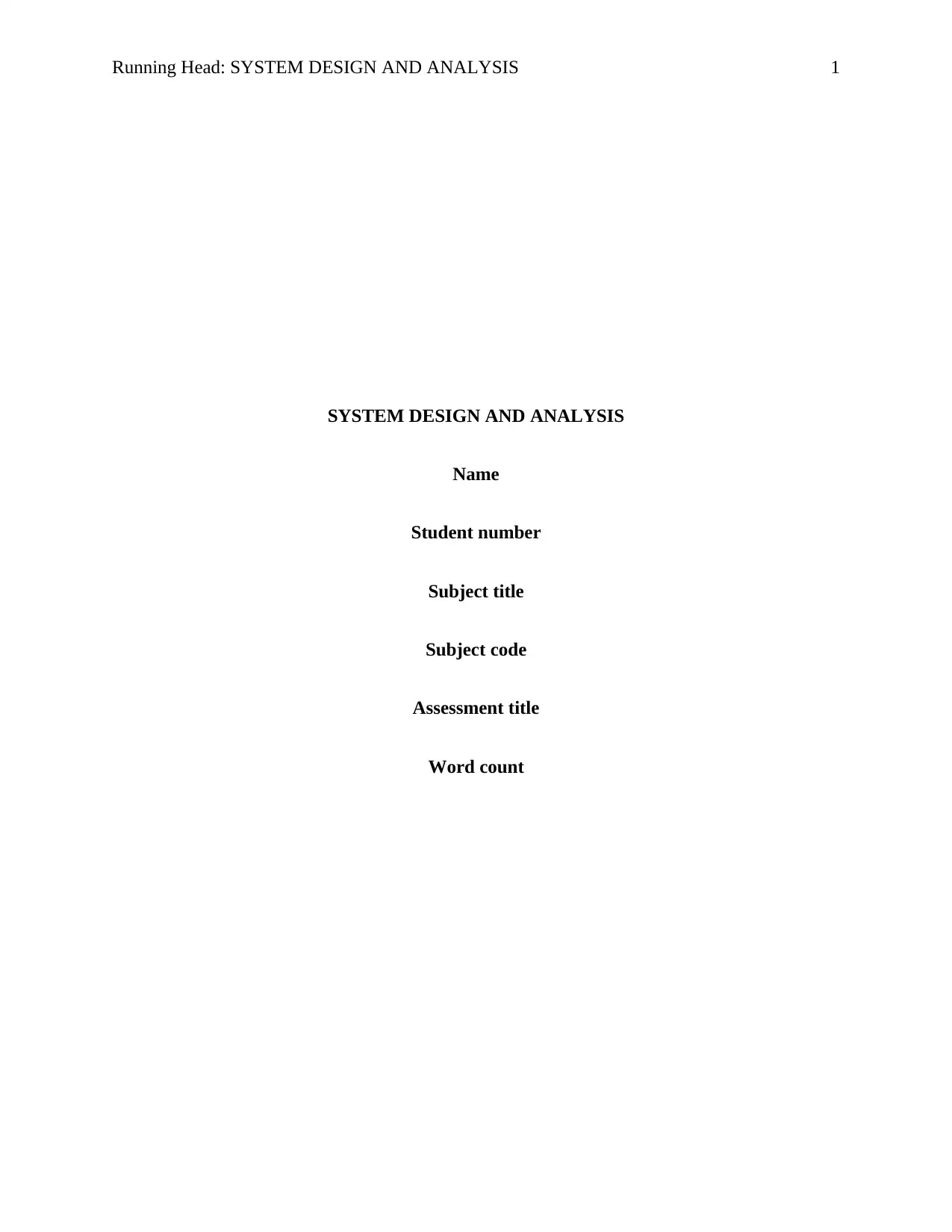
Running Head: SYSTEM DESIGN AND ANALYSIS 1
SYSTEM DESIGN AND ANALYSIS
Name
Student number
Subject title
Subject code
Assessment title
Word count
SYSTEM DESIGN AND ANALYSIS
Name
Student number
Subject title
Subject code
Assessment title
Word count
Paraphrase This Document
Need a fresh take? Get an instant paraphrase of this document with our AI Paraphraser
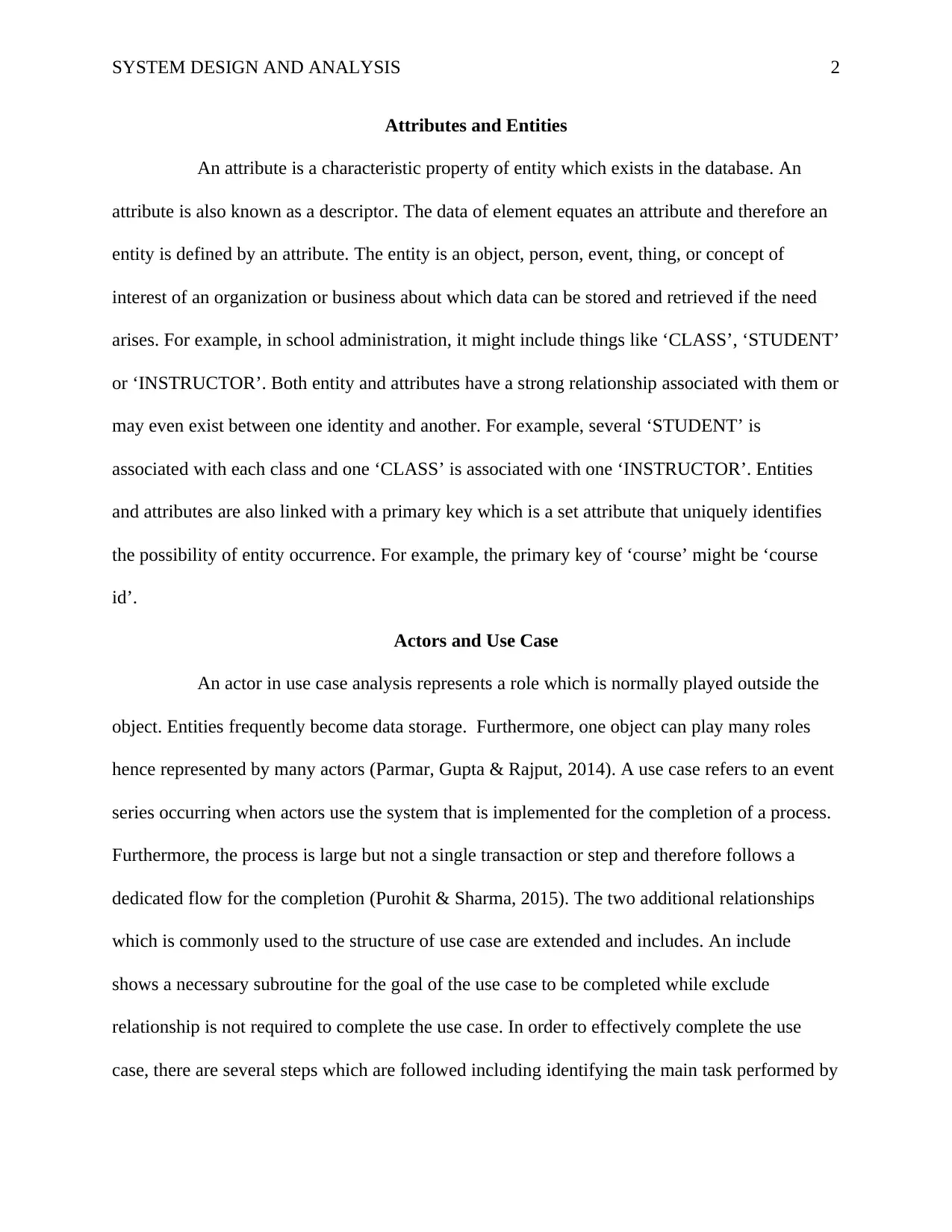
SYSTEM DESIGN AND ANALYSIS 2
Attributes and Entities
An attribute is a characteristic property of entity which exists in the database. An
attribute is also known as a descriptor. The data of element equates an attribute and therefore an
entity is defined by an attribute. The entity is an object, person, event, thing, or concept of
interest of an organization or business about which data can be stored and retrieved if the need
arises. For example, in school administration, it might include things like ‘CLASS’, ‘STUDENT’
or ‘INSTRUCTOR’. Both entity and attributes have a strong relationship associated with them or
may even exist between one identity and another. For example, several ‘STUDENT’ is
associated with each class and one ‘CLASS’ is associated with one ‘INSTRUCTOR’. Entities
and attributes are also linked with a primary key which is a set attribute that uniquely identifies
the possibility of entity occurrence. For example, the primary key of ‘course’ might be ‘course
id’.
Actors and Use Case
An actor in use case analysis represents a role which is normally played outside the
object. Entities frequently become data storage. Furthermore, one object can play many roles
hence represented by many actors (Parmar, Gupta & Rajput, 2014). A use case refers to an event
series occurring when actors use the system that is implemented for the completion of a process.
Furthermore, the process is large but not a single transaction or step and therefore follows a
dedicated flow for the completion (Purohit & Sharma, 2015). The two additional relationships
which is commonly used to the structure of use case are extended and includes. An include
shows a necessary subroutine for the goal of the use case to be completed while exclude
relationship is not required to complete the use case. In order to effectively complete the use
case, there are several steps which are followed including identifying the main task performed by
Attributes and Entities
An attribute is a characteristic property of entity which exists in the database. An
attribute is also known as a descriptor. The data of element equates an attribute and therefore an
entity is defined by an attribute. The entity is an object, person, event, thing, or concept of
interest of an organization or business about which data can be stored and retrieved if the need
arises. For example, in school administration, it might include things like ‘CLASS’, ‘STUDENT’
or ‘INSTRUCTOR’. Both entity and attributes have a strong relationship associated with them or
may even exist between one identity and another. For example, several ‘STUDENT’ is
associated with each class and one ‘CLASS’ is associated with one ‘INSTRUCTOR’. Entities
and attributes are also linked with a primary key which is a set attribute that uniquely identifies
the possibility of entity occurrence. For example, the primary key of ‘course’ might be ‘course
id’.
Actors and Use Case
An actor in use case analysis represents a role which is normally played outside the
object. Entities frequently become data storage. Furthermore, one object can play many roles
hence represented by many actors (Parmar, Gupta & Rajput, 2014). A use case refers to an event
series occurring when actors use the system that is implemented for the completion of a process.
Furthermore, the process is large but not a single transaction or step and therefore follows a
dedicated flow for the completion (Purohit & Sharma, 2015). The two additional relationships
which is commonly used to the structure of use case are extended and includes. An include
shows a necessary subroutine for the goal of the use case to be completed while exclude
relationship is not required to complete the use case. In order to effectively complete the use
case, there are several steps which are followed including identifying the main task performed by
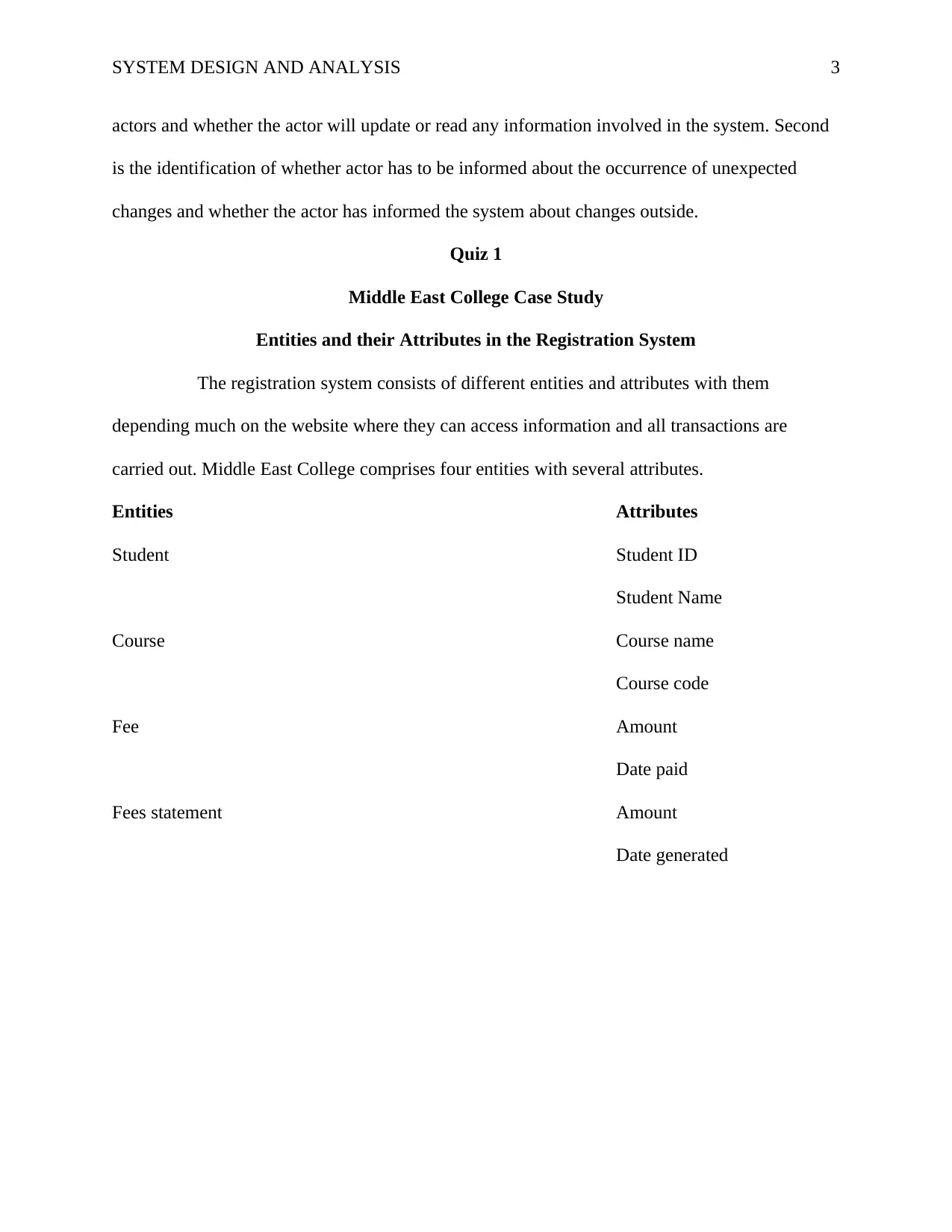
SYSTEM DESIGN AND ANALYSIS 3
actors and whether the actor will update or read any information involved in the system. Second
is the identification of whether actor has to be informed about the occurrence of unexpected
changes and whether the actor has informed the system about changes outside.
Quiz 1
Middle East College Case Study
Entities and their Attributes in the Registration System
The registration system consists of different entities and attributes with them
depending much on the website where they can access information and all transactions are
carried out. Middle East College comprises four entities with several attributes.
Entities Attributes
Student Student ID
Student Name
Course Course name
Course code
Fee Amount
Date paid
Fees statement Amount
Date generated
actors and whether the actor will update or read any information involved in the system. Second
is the identification of whether actor has to be informed about the occurrence of unexpected
changes and whether the actor has informed the system about changes outside.
Quiz 1
Middle East College Case Study
Entities and their Attributes in the Registration System
The registration system consists of different entities and attributes with them
depending much on the website where they can access information and all transactions are
carried out. Middle East College comprises four entities with several attributes.
Entities Attributes
Student Student ID
Student Name
Course Course name
Course code
Fee Amount
Date paid
Fees statement Amount
Date generated
⊘ This is a preview!⊘
Do you want full access?
Subscribe today to unlock all pages.

Trusted by 1+ million students worldwide
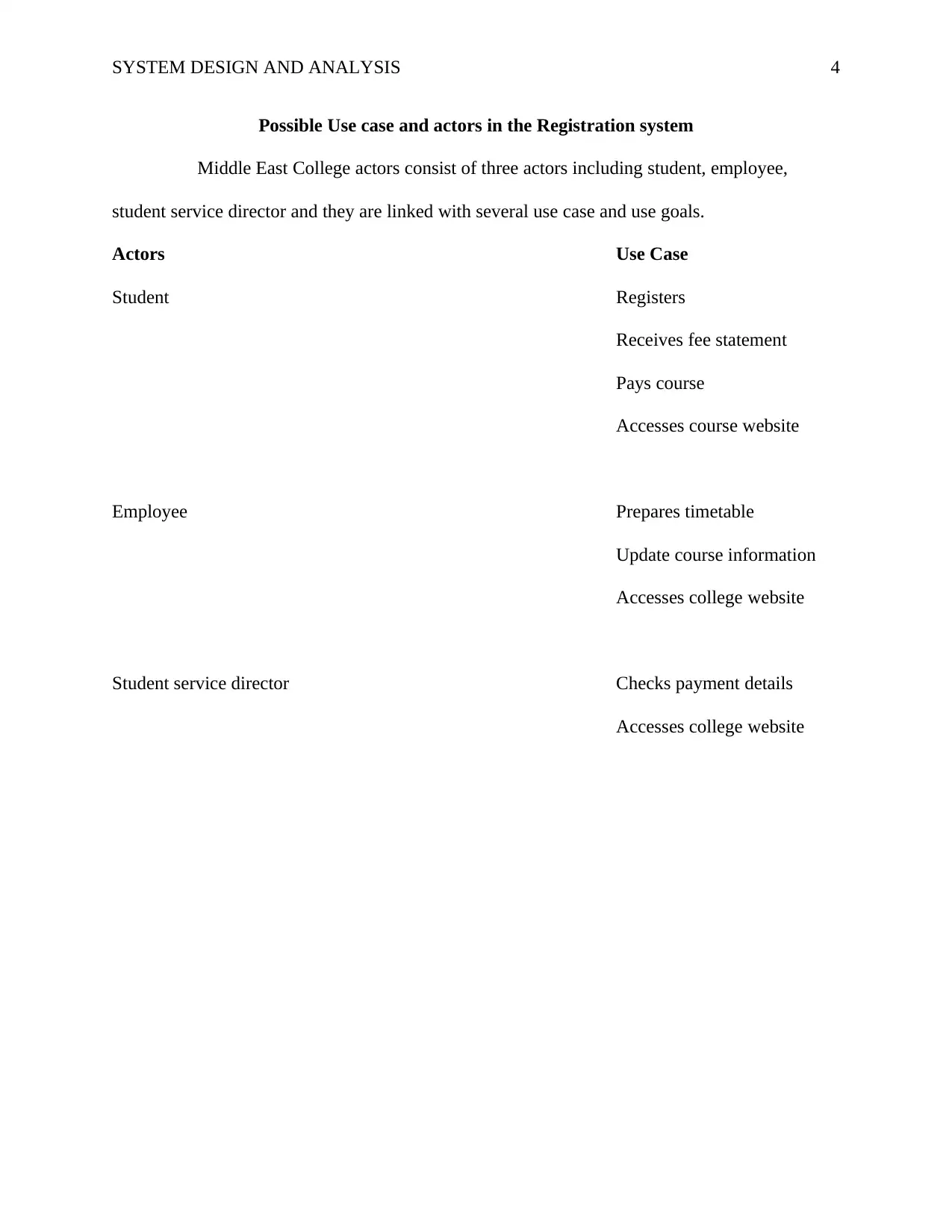
SYSTEM DESIGN AND ANALYSIS 4
Possible Use case and actors in the Registration system
Middle East College actors consist of three actors including student, employee,
student service director and they are linked with several use case and use goals.
Actors Use Case
Student Registers
Receives fee statement
Pays course
Accesses course website
Employee Prepares timetable
Update course information
Accesses college website
Student service director Checks payment details
Accesses college website
Possible Use case and actors in the Registration system
Middle East College actors consist of three actors including student, employee,
student service director and they are linked with several use case and use goals.
Actors Use Case
Student Registers
Receives fee statement
Pays course
Accesses course website
Employee Prepares timetable
Update course information
Accesses college website
Student service director Checks payment details
Accesses college website
Paraphrase This Document
Need a fresh take? Get an instant paraphrase of this document with our AI Paraphraser
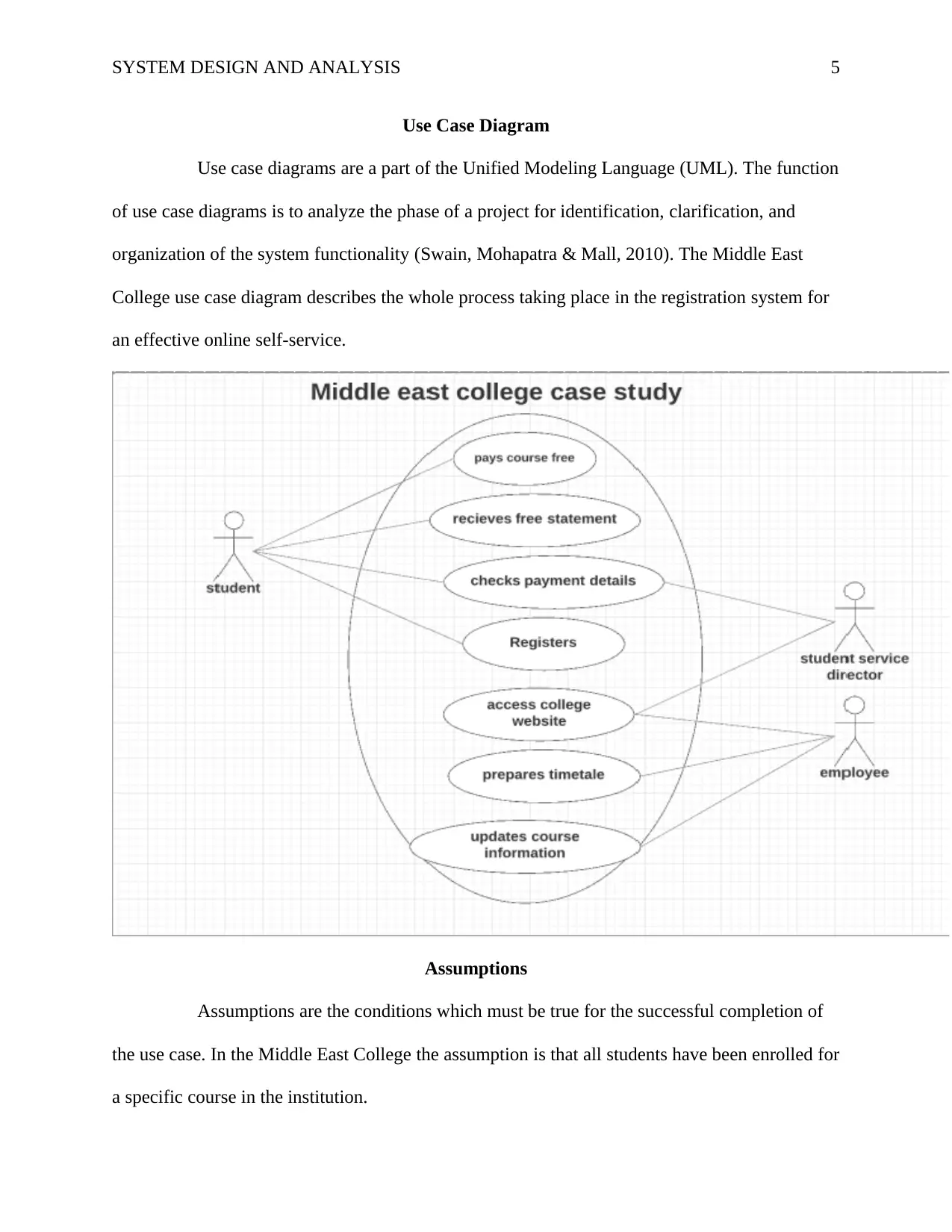
SYSTEM DESIGN AND ANALYSIS 5
Use Case Diagram
Use case diagrams are a part of the Unified Modeling Language (UML). The function
of use case diagrams is to analyze the phase of a project for identification, clarification, and
organization of the system functionality (Swain, Mohapatra & Mall, 2010). The Middle East
College use case diagram describes the whole process taking place in the registration system for
an effective online self-service.
Assumptions
Assumptions are the conditions which must be true for the successful completion of
the use case. In the Middle East College the assumption is that all students have been enrolled for
a specific course in the institution.
Use Case Diagram
Use case diagrams are a part of the Unified Modeling Language (UML). The function
of use case diagrams is to analyze the phase of a project for identification, clarification, and
organization of the system functionality (Swain, Mohapatra & Mall, 2010). The Middle East
College use case diagram describes the whole process taking place in the registration system for
an effective online self-service.
Assumptions
Assumptions are the conditions which must be true for the successful completion of
the use case. In the Middle East College the assumption is that all students have been enrolled for
a specific course in the institution.
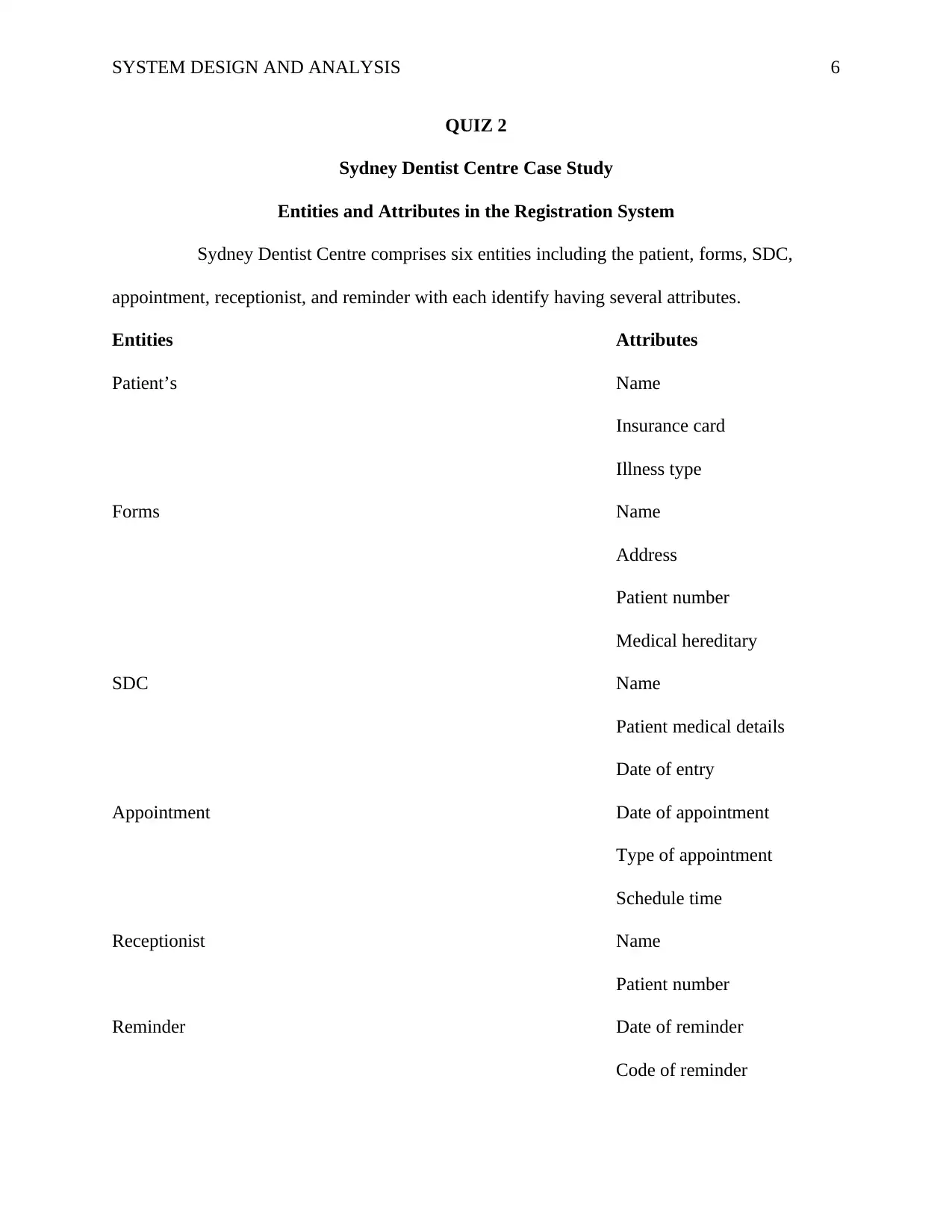
SYSTEM DESIGN AND ANALYSIS 6
QUIZ 2
Sydney Dentist Centre Case Study
Entities and Attributes in the Registration System
Sydney Dentist Centre comprises six entities including the patient, forms, SDC,
appointment, receptionist, and reminder with each identify having several attributes.
Entities Attributes
Patient’s Name
Insurance card
Illness type
Forms Name
Address
Patient number
Medical hereditary
SDC Name
Patient medical details
Date of entry
Appointment Date of appointment
Type of appointment
Schedule time
Receptionist Name
Patient number
Reminder Date of reminder
Code of reminder
QUIZ 2
Sydney Dentist Centre Case Study
Entities and Attributes in the Registration System
Sydney Dentist Centre comprises six entities including the patient, forms, SDC,
appointment, receptionist, and reminder with each identify having several attributes.
Entities Attributes
Patient’s Name
Insurance card
Illness type
Forms Name
Address
Patient number
Medical hereditary
SDC Name
Patient medical details
Date of entry
Appointment Date of appointment
Type of appointment
Schedule time
Receptionist Name
Patient number
Reminder Date of reminder
Code of reminder
⊘ This is a preview!⊘
Do you want full access?
Subscribe today to unlock all pages.

Trusted by 1+ million students worldwide
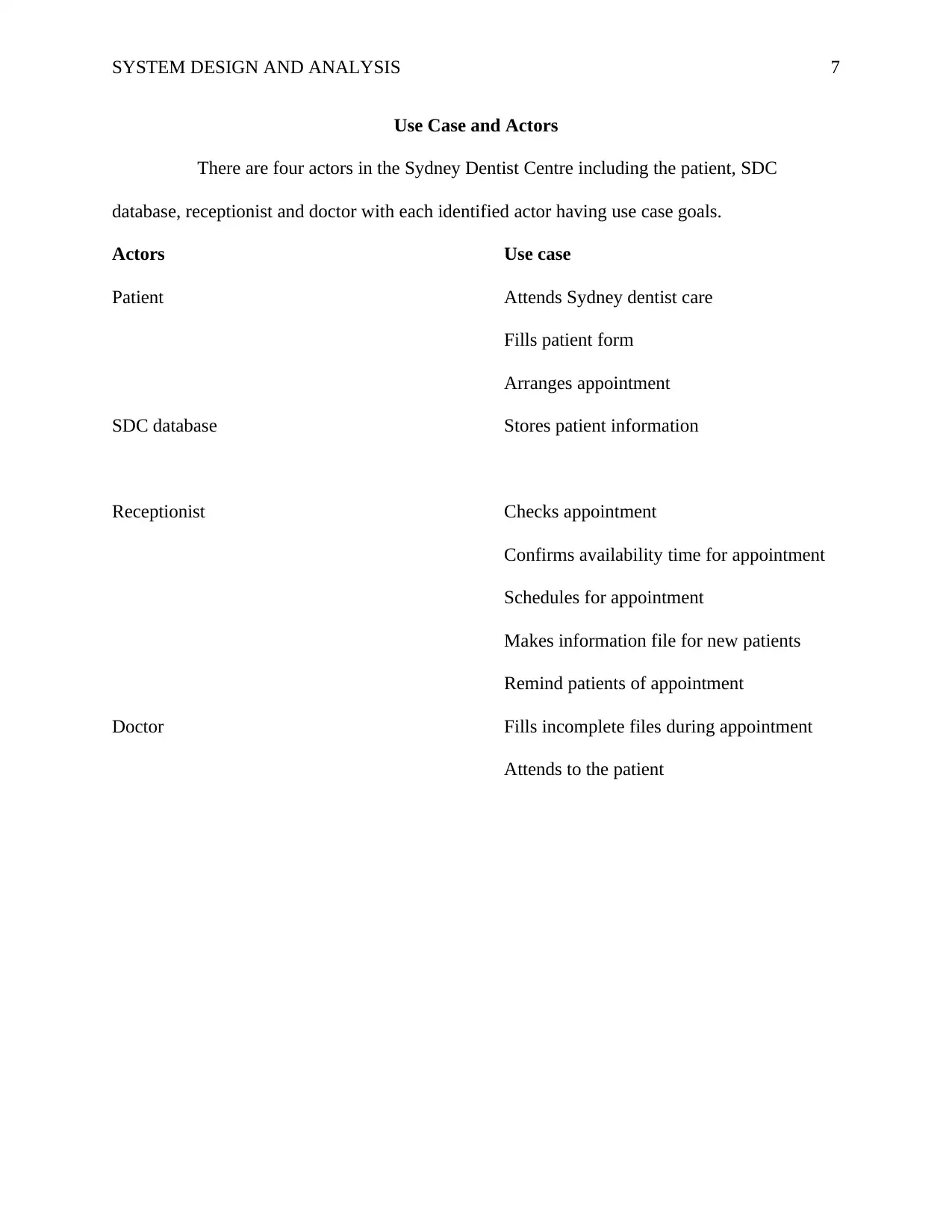
SYSTEM DESIGN AND ANALYSIS 7
Use Case and Actors
There are four actors in the Sydney Dentist Centre including the patient, SDC
database, receptionist and doctor with each identified actor having use case goals.
Actors Use case
Patient Attends Sydney dentist care
Fills patient form
Arranges appointment
SDC database Stores patient information
Receptionist Checks appointment
Confirms availability time for appointment
Schedules for appointment
Makes information file for new patients
Remind patients of appointment
Doctor Fills incomplete files during appointment
Attends to the patient
Use Case and Actors
There are four actors in the Sydney Dentist Centre including the patient, SDC
database, receptionist and doctor with each identified actor having use case goals.
Actors Use case
Patient Attends Sydney dentist care
Fills patient form
Arranges appointment
SDC database Stores patient information
Receptionist Checks appointment
Confirms availability time for appointment
Schedules for appointment
Makes information file for new patients
Remind patients of appointment
Doctor Fills incomplete files during appointment
Attends to the patient
Paraphrase This Document
Need a fresh take? Get an instant paraphrase of this document with our AI Paraphraser
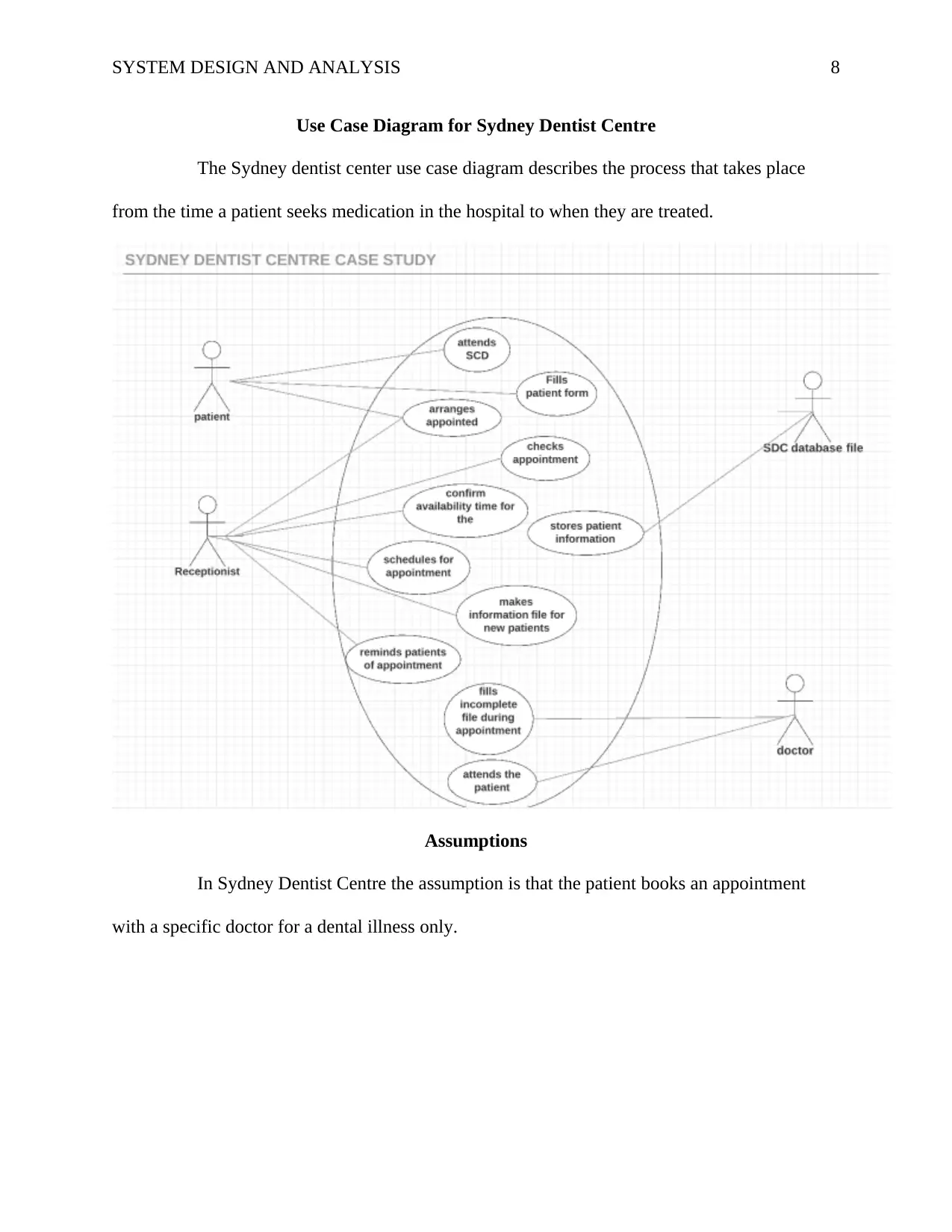
SYSTEM DESIGN AND ANALYSIS 8
Use Case Diagram for Sydney Dentist Centre
The Sydney dentist center use case diagram describes the process that takes place
from the time a patient seeks medication in the hospital to when they are treated.
Assumptions
In Sydney Dentist Centre the assumption is that the patient books an appointment
with a specific doctor for a dental illness only.
Use Case Diagram for Sydney Dentist Centre
The Sydney dentist center use case diagram describes the process that takes place
from the time a patient seeks medication in the hospital to when they are treated.
Assumptions
In Sydney Dentist Centre the assumption is that the patient books an appointment
with a specific doctor for a dental illness only.
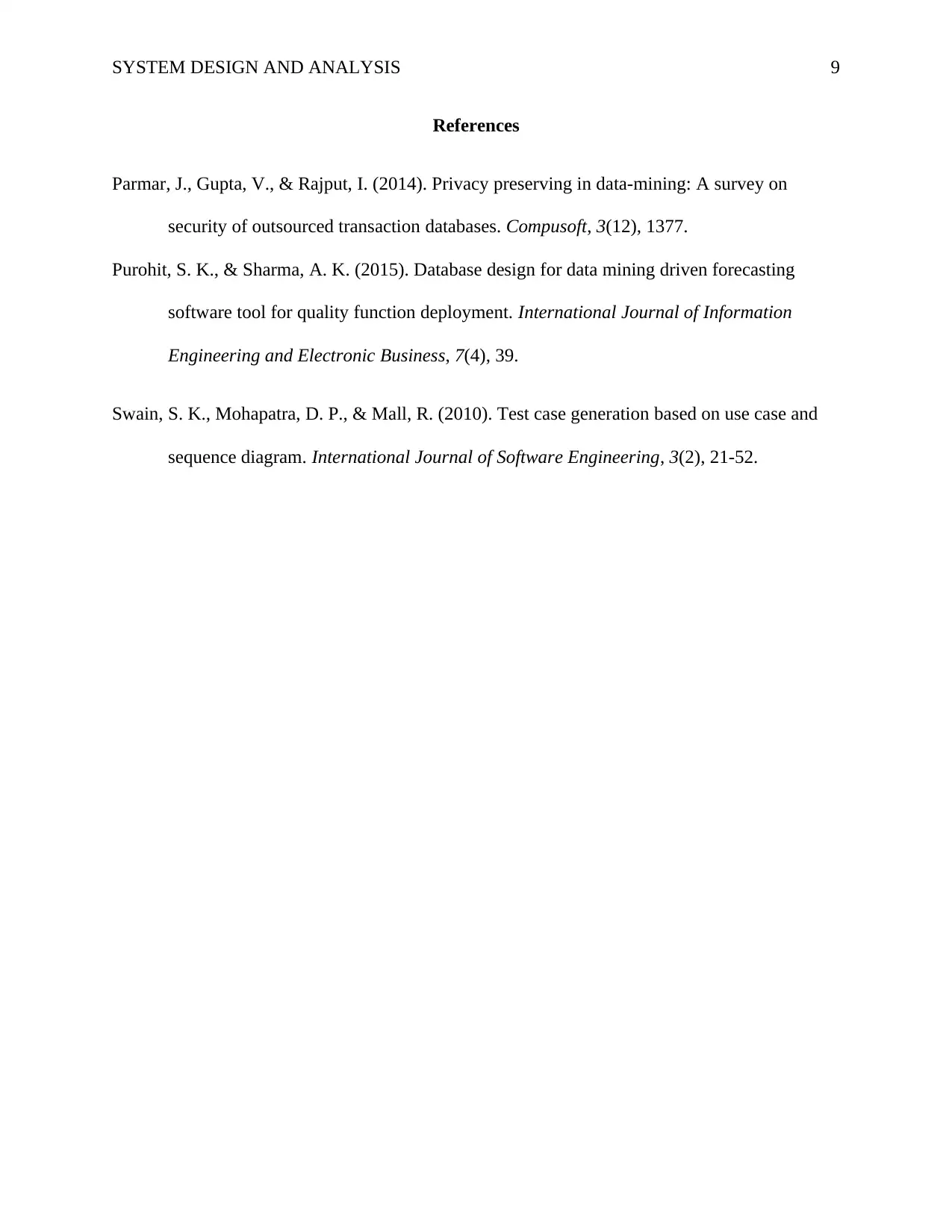
SYSTEM DESIGN AND ANALYSIS 9
References
Parmar, J., Gupta, V., & Rajput, I. (2014). Privacy preserving in data-mining: A survey on
security of outsourced transaction databases. Compusoft, 3(12), 1377.
Purohit, S. K., & Sharma, A. K. (2015). Database design for data mining driven forecasting
software tool for quality function deployment. International Journal of Information
Engineering and Electronic Business, 7(4), 39.
Swain, S. K., Mohapatra, D. P., & Mall, R. (2010). Test case generation based on use case and
sequence diagram. International Journal of Software Engineering, 3(2), 21-52.
References
Parmar, J., Gupta, V., & Rajput, I. (2014). Privacy preserving in data-mining: A survey on
security of outsourced transaction databases. Compusoft, 3(12), 1377.
Purohit, S. K., & Sharma, A. K. (2015). Database design for data mining driven forecasting
software tool for quality function deployment. International Journal of Information
Engineering and Electronic Business, 7(4), 39.
Swain, S. K., Mohapatra, D. P., & Mall, R. (2010). Test case generation based on use case and
sequence diagram. International Journal of Software Engineering, 3(2), 21-52.
⊘ This is a preview!⊘
Do you want full access?
Subscribe today to unlock all pages.

Trusted by 1+ million students worldwide
1 out of 9
Related Documents
Your All-in-One AI-Powered Toolkit for Academic Success.
+13062052269
info@desklib.com
Available 24*7 on WhatsApp / Email
![[object Object]](/_next/static/media/star-bottom.7253800d.svg)
Unlock your academic potential
Copyright © 2020–2025 A2Z Services. All Rights Reserved. Developed and managed by ZUCOL.




